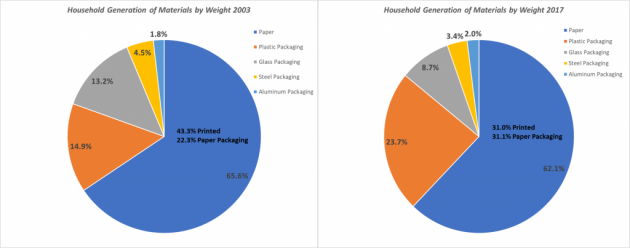
Fewer newspapers but more packaging in Ontario households
By John Mullinder
Sustainability Paperboard Packaging Plastic Paper PET Plastic PPECThe generation of printed paper that ends up in Ontario homes has fallen.
While the collective weight of Blue Box materials generated by Ontario households has not changed much over the last 15 years, the type of material that ends up there certainly has.
Far fewer newspapers, for starters. Almost 136,000 tonnes fewer, according to a PPEC comparison of Stewardship Ontario generation data between 2003 and 2017.
Magazines and catalogues have also taken a hit (41,000 tonnes less) together with printing and writing paper (down 13,000 tonnes). Telephone directories, not surprisingly, are on the way out. Overall, the generation of printed paper that ends up in Ontario homes has fallen some 35% over the period, mainly because of inroads made by electronic or digital competition. Millennials (and there are many more of them these days) are not known as great newspaper readers.
Counterbalancing these losses are big tonnage gains in both plastic and paper packaging: some 99,000 more tonnes of plastic (mostly the grab-bag of “Other Plastics” and PET bottles); and 89,000 more tonnes of paper (mainly corrugated boxes and boxboard cartons). The spread of E-commerce delivery is expected to boost residential corrugated box tonnages even more in future years.
The table above shows the net change in tonnages of some of the materials generated by Ontario households between 2003 and 2017 (with the losing categories highlighted in yellow) while the pie-charts give a graphic comparison by material group.

Advertisement

